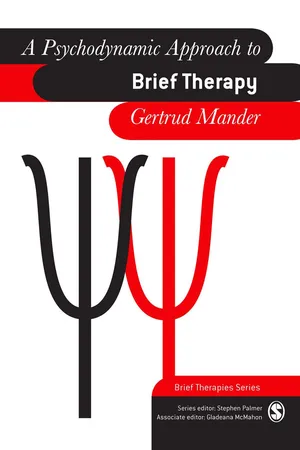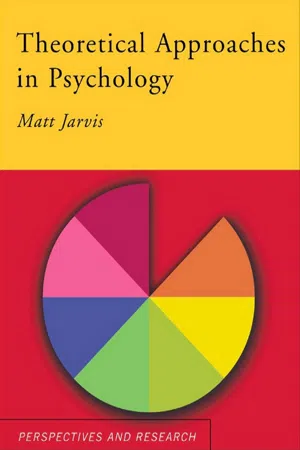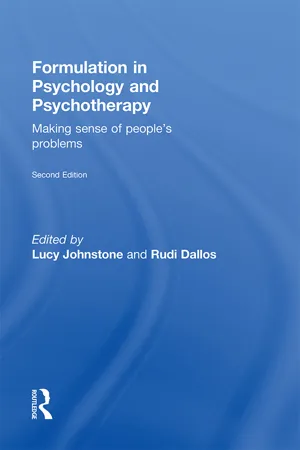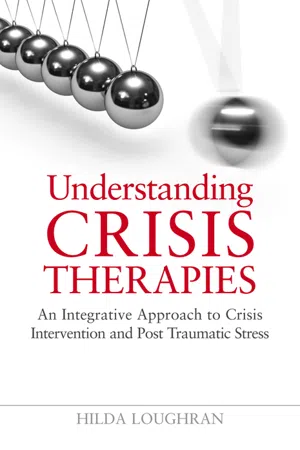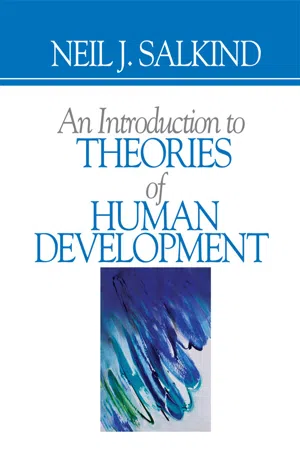Psychology
Psychodynamic Approach
The psychodynamic approach in psychology emphasizes the role of unconscious processes and early childhood experiences in shaping an individual's personality and behavior. It was developed by Sigmund Freud and focuses on understanding the interplay between the id, ego, and superego. This approach also involves exploring defense mechanisms and the influence of unresolved conflicts on mental health.
Written by Perlego with AI-assistance
Related key terms
11 Key excerpts on "Psychodynamic Approach"
- eBook - ePub
- Gertrud Mander(Author)
- 2000(Publication Date)
- SAGE Publications Ltd(Publisher)
Quite often there is an implication, when referring to trainings or to practitioners, that the Psychodynamic Approach is a lesser breed than the psychoanalytic one, perhaps somewhat watered down, or, as I have heard it described, more broadly based, eclectic, flexible and enriched by ingredients from the social dimension in addition to ‘strict and tendentious psychoanalysis’, as Freud (1919) put it. In terms of the process, ‘psychodynamic’ is descriptive of a connection between the inner and the outer world in relation to the therapeutic interaction in each individual case, while ‘psychoanalytic’ can be seen as referring both to technical aspects of clinical practice and to a rigorous stance of analysing and interpreting clinical material in the transference, which excludes other, more ‘real’, active or direct forms of intervention. This distinction is important as it implies a fundamental difference, as between purity and admixture, and a juggling of different styles and approaches as befits the occasion, while at bottom retaining fundamental articles of belief, of which the ‘pure gold of psychoanalysis’ is the most essential.In principle, the Psychodynamic Approach in counselling and psychotherapy is based on a body of theory that was developed over the past hundred years by several generations of psychoanalysts, beginning with Freud’s studies on hysteria, his theorizing about the psycho-neuroses and his construction of a hypothetical model of the human mind, which had topographical and structural features and assumed conscious as well as preconscious and unconscious ways of mental functioning. Studying clinical material from patients and analysing his own dreams, Freud came to hypothesize that the mental apparatus consisted of the three different parts of superego, ego and id which control the mental and instinctual processes in varying degrees, operating together, or in conflict with each other, in the course of human development, depending on the satisfaction and gratification of the human being’s sexual instincts which are activated by his or her oral, anal and genital needs. Provided the child’s development from initial dependence to gradual autonomy proceeds well, is managed adequately by parental caregivers, and not disturbed by traumatic interferences from within or without, Freud assumed a steady progress from infancy through adolescence to adulthood, leading naturally from the dependant nursing dyad with the mother via the interdependent oedipal triad from which the child should emerge strengthened to form mutually satisfying relationships with parents, siblings and peers, and eventually arrive at mature adulthood and at the ability ‘to love and work’. - eBook - ePub
- Matt Jarvis(Author)
- 2005(Publication Date)
- Routledge(Publisher)
3 Psychodynamic psychology
Key assumptions of the approach Freud’s theories Winnicott’s theories Key application: mental health Contemporary issue: why do we love monsters? Contributions and limitations of the Psychodynamic Approach SummaryKey assumptions of the approach
Have you ever had the experience of doing something out of character such as taking an instant dislike to a stranger, or forgetting to go to an appointment that was important but which you were secretly dreading? If you have, then the chances are that you were influenced by unconscious mental processes—i.e. wishes, emotions, etc. of which you were not aware. You might for example have disliked the stranger because they reminded you of someone else, or forgotten the appointment because you simply did not want to go. The Psychodynamic Approach is an approach to psychology which emphasises these unconscious processes. The way in which a psychodynamic psychologist might look at unconscious processes is well-illustrated by the case of Alex, described by Lemma-Wright (1995).Alex was the older of two sisters. She loved her sister dearly, but had always resented her a little, believing that her family had always doted on her sister while ignoring her. As a child Alex had once become so angry with her sister for being the centre of attention that she dragged her into the sea, frightening her badly. As an adult, Alex frequently found herself feeling obliged to organise things for her sister and to help her out of financial difficulties. One weekend Alex organised sea boat-trip to celebrate her sister‘s birthday. The trip went well, but Alex suffered a panic attack on the boat. She had no idea why until a few days later she had a dream in which she had a fight with a friend (who reminded her of her sister) and wished her dead. It then became clear that - eBook - ePub
- Naomi Moller, Andreas Vossler, David W Jones, David Kaposi, Naomi Moller, Andreas Vossler, David W Jones, David Kaposi(Authors)
- 2020(Publication Date)
- SAGE Publications Ltd(Publisher)
Chapter 3 ) was also the discovery of a very special kind of listening process, and a special type of psychic reality. The distinguishing features of the contemporary Psychodynamic Approach remain in keeping with these discoveries, despite many important changes in theory and practice. The Psychodynamic Approach continues to posit that, to alleviate mental distress, the therapist must engage with a directly inexpressible, dynamic unconscious realm of mental life, which originates in the vicissitudes of highly charged early experiences of love and hate.This chapter aims to:- introduce the central psychodynamic concept of unconscious communication
- introduce the origins of the dynamic unconscious and explain how it can inform our understanding of mental health
- outline the process of psychodynamic therapy – how unconscious communication may manifest and how it can be dealt with in therapy
- discuss the Psychodynamic Approach’s relationship to outcome research.
1 Core psychodynamic principles and their development
The development of the Psychodynamic Approach entailed a progressive expansion of the realm of unconscious communication, through which consciously inexpressible feelings of love and hate are communicated and understood.Unconscious communication Unintentional acts by which directly inaccessible psychic states are expressed.Freud’s treatment of reminiscences continued with the clients’ memories themselves, which he took to mean something more than what appeared on the surface. First, he traced troubling memories of relatively recent origin back to early traumatic experiences. Then, he considered how these early experiences themselves expressed more than what they seemed to – Freud understood the memories of early experiences as representing not simply historical truth (objective events that happened between parent and child) but also traumatising infantile impulses (the fears and desires central to the Oedipus complex, as outlined in Chapter 3 - eBook - ePub
Applied Sport, Exercise, and Performance Psychology
Current Approaches to Helping Clients
- David Tod, Martin Eubank(Authors)
- 2020(Publication Date)
- Routledge(Publisher)
2 Psychodynamic ApproachesFernanda Serra de Queiroz and Mark B. AndersenPsychodynamic therapies encompass a wide variety of treatment models such as classic psychoanalysis, Jungian analytical psychology, Adlerian individual psychology, object-relations therapy, and many other models (e.g., Horney, Winnicott, interpersonal psychotherapy, ego psychology, Kohut, Bion). The common threads they all have are the importance of early childhood experiences, the role of the unconscious, defence mechanisms, transference and countertransference, and the quality of the client-therapist relationship. In sport psychology, a Psychodynamic Approach may not be a model to use as a basis for interventions in many cases because the goals of the athletes are to learn mental skills to help with performance, but for those athletes who want to explore their lives and how they got to where they are now, this approach may be helpful. From an indirect point of view, sport psychologists may use psychodynamic theories to understand (case conceptualisation) their relationships with their athletes, their athletes’ ontogenetic histories, the foundations of their athletes’ dysregulations, and why their athletes relate to significant others in their sports and their lives in dysfunctional (and functional) ways. In this chapter, we are not proposing that sport psychologists should adopt a Psychodynamic Approach with their clients, but rather consider that psychodynamic conceptualisations may be useful when working with their clients and how understanding their interpersonal dynamics with their clients may be a key to helping them.Historical context
With the rise of behaviourism and cognitive behavioural therapy, psychodynamic theory and practice, in the last several decades, has lost ground in the curricula of psychology and exercise science degrees in North America and the British Commonwealth. Critics of psychodynamic theory have argued that there was little scientific evidence to support many of Freud’s claims (see Conroy & Benjamin, 2001). Nevertheless, in some countries, such as Brazil (the first author’s country of origin), psychoanalysis still thrives. As Mendes (2002) commented on Brazilian society, “Psychoanalytic concepts are so amalgamated in our social environment that we cannot imagine the world without its influence” (p. 81). - Dominic Upton(Author)
- 2013(Publication Date)
- Routledge(Publisher)
Differences between the dissatisfied CBT and PDT patients: Both patients experienced major problems in their relations to the therapists, but in different ways: CBT patients considered the therapist to be intrusive and oppressive; PDT patients felt the therapist was withdrawn, disengaged. The CBT patients were very disappointed and negative whereas the PDT patients were ambivalent.ImplicationsDissatisfied patients should be identified and asked about the reasons for their feeling and advised to try some other type of psychotherapy or another therapist who may better meet their needs and complaints.2.22 SummaryPsychological approaches to the person attempt to explain why people behave in a certain manner. Understanding the person requires an appreciation of a number of psychological perspectives. The Psychodynamic Approach explores how the unconscious mind is responsible for behaviour. Freud’s psychoanalytic approach suggests behaviour is a result of an interaction between innate drives and early experiences in childhood. According to Freud, the mind has three levels: the conscious, pre-conscious and unconscious. Freud also assumed that the mind could be divided into three basic sections the id (innate), ego (reality) and superego (morals). The ego protects itself by a number of defence mechanisms. Freud’s ideas have fallen out of favour or have been adapted to incorporate more social rather than sexual influences. A criticism of Freudian and other psychodynamic theories is that they do not translate into measurable observations and are therefore untestable. According to behaviourists, all behaviour is learnt from the environment (to the near exclusion of innate or inherited factors). Early behaviourist theories suggest that learning and behaviour are the result of conditioning (classical or operant). The focus of the behavioural approach is on the patient’s behavioural symptoms rather than on the underlying causes of the behaviour itself. - eBook - ePub
Psychodynamic Therapy
Conceptual and Empirical Foundations
- Steven K. Huprich(Author)
- 2010(Publication Date)
- Routledge(Publisher)
Section I Theoretical UnderpinningsPassage contains an image
2Basic Principles of Psychoanalytic and Psychodynamic Theory
Although psychoanalytic theory and its implication for treatment have evolved substantially over time (Frank, 2000; Kernberg, 1993; Marcus, 1999; Pine, 1998; Rangell, 1981; Wallerstein, 1989, 2002), certain principles remain as guiding elements as part of any discussion of psychoanalytic or psychodynamic psychotherapy. As noted in Chapter 1 , these are summarized by Westen (1998, pp. 334–335):1. Much of mental life—including thoughts, feelings, and motives— is unconscious, which means that people can behave in ways or develop symptoms that are inexplicable to themselves.2. Mental processes, including affective and motivational processes, operate in parallel so that, toward the same person or situation, individuals can have conflicting feelings that motivate them in opposing ways and oft en lead to compromise solutions.3. Stable personality patterns begin to form in childhood, and childhood experiences play an important role in personality development, particularly in shaping the ways people form later social relationships.4. Mental representations of the self, others, and relationships guide people’s interactions with others and influence the ways they become psychologically symptomatic. 5. Personality development involves not only learning to regulate sexual and aggressive feelings but also moving from an immature, socially dependent state to a mature, interdependent state.It is perhaps these five principles that best distinguish psychodynamic and psychoanalytic psychotherapy from other forms of treatment that are commonly practiced today, which focus mainly on conscious cognitions, behavior change, and symptom reduction. Psychotherapy process also is part of psychoanalytic and psychodynamic theory, unlike many of the common therapies espoused to be empirically superior. Issues of how the patient responds to the therapist, how the therapist responds to the patient, how and when a person resists a particular topic of investigation, and how all these processes change in the course of the session are part of understanding and conducting sound psychodynamic and psychoanalytic treatment. - eBook - ePub
Formulation in Psychology and Psychotherapy
Making sense of people's problems
- Lucy Johnstone, Rudi Dallos(Authors)
- 2013(Publication Date)
- Routledge(Publisher)
Within the array of ideas and approaches that constitutes the psychodynamic tradition, there is, nonetheless, a commonality of outlook which holds the different strands together (Leiper and Maltby, 2004; Wallerstein, 2002). This is not the enforced unity of ideas that Freud once thought was essential to protect the analytic ideal from watered-down versions or wild practitioners. However, certain key perspectives and shared values constitute the essentials of a coherent approach. At its most basic, what is held in common exists at the level of the perception of the human condition rather than its conceptualisation: it is, in a sense, pre-theoretical. This shared vision forms the basis of a recognizable clinical orientation – a sensibility about the nature of therapeutic practice – rather than an articulated psychological paradigm. Such a general way of looking at clinical material leaves a lot of scope for diversity in what an ‘accurate’, or even a simply useful, formulation might look like.Core features of a Psychodynamic ApproachWhat ideas constitute the core of the Psychodynamic Approach? Perhaps the most fundamental one is the focus on psychological or emotional pain. Life is thought of as a difficult and demanding process and the psyche is constructed in the struggle to deal with it. What is ‘dynamic’ is the turbulence created in the currents of mental life by these struggles. Means of avoiding pain are developed: ways of seeing, thinking, feeling and behaving can all serve this purpose. Much of this activity takes place out of awareness. There is an ‘internal world’ constituted differently from external reality, the unconscious elements of which have a fundamental influence on the way we live our lives. These unconscious attempts to avoid pain often fail, but since our awareness is limited, they are nonetheless repeated again and again. Failing defences are what give form to and maintain patterns of psychological disorder. Therapy is about getting in touch with thoughts and feelings which were previously ‘warded off’, kept hidden from the conscious mind because they seemed to be too much to deal with. Psychodynamic therapy is about helping the client to ‘re-formulate’ what they are experiencing in a more inclusive way, and to tolerate the discomfort that this involves. The understanding that the therapist and client develop about these difficulties expands the client’s awareness and opens up new options for managing conflict. The client’s capacity to bear emotional pain and cope constructively with dissatisfaction is enhanced, and the ability to reflect on and be curious about their experience is developed. - eBook - ePub
Understanding Crisis Therapies
An Integrative Approach to Crisis Intervention and Post Traumatic Stress
- Hilda Loughran(Author)
- 2011(Publication Date)
- Jessica Kingsley Publishers(Publisher)
Chapter 2
A Psychoanalytic Approach
Valerie RichardsonIntroduction
This is the first of seven chapters which will explore a specific theoretical framework or school of thought attempting to explain human interaction. The chapters will progress in a sequence that mirrors the development of our understanding over time. Psychoanalytic theory, the subject of this chapter is a long established and some would argue the most influential of the theoretical frameworks of human nature emanating principally from psychology. As with each subsequent chapter we will start by looking at a brief history of the theory and connecting this to the theories and beliefs that were prevailing at the time of its development.A brief history
Aguilera (1990) states that ‘a broad range of theories of human behaviour including those of Freud, Hartmann, Rado, Erikson, Lindemann and Caplan’ (p.2) have contributed to the development of crisis intervention as a therapeutic model and no one theory of behaviour can be cited as a primary influence on its development. However, the work of Freud (1900) was the earliest conceptual framework to influence the development of crisis intervention as a therapeutic process.Prior to Freud’s work psychology as a subject had been a static discipline based on concepts drawn from biology and physiology and which was slowly moving to include sociological ideas. Early understanding of personality was based on the mediaeval ideas of the link between the body and behaviour. The four humours of sanguine, phlegmatic, melancholic and choleric were based on four biological elements, blood, phlegm, black bile and yellow bile. Each of these elements represented a type of personality, sanguine being optimistic, cheerful and even tempered, phlegmatic being calm and unemotional, melancholic being despondent and depressive and choleric being mean spirited, easily angered and bad tempered. Work by Descartes in the first half of the 17th century (Cottingham, Stoothoff and Murdoch 1988) introduced the idea of dualism, where the mind and the body were two separate entities that interacted to form the human experience. - eBook - ePub
Foundations of Counseling and Psychotherapy
Evidence-Based Practices for a Diverse Society
- David Sue, Diane M. Sue(Authors)
- 2012(Publication Date)
- Wiley(Publisher)
To address current modifications, we will focus more on psychoanalysis as it is practiced today. We will use the terms, psychodynamic or psychoanalytic, to designate modified forms of psychoanalysis. In this chapter, we will first present the different models of psychodynamic theory and discuss how they have evolved over time. Second, we will consider the different techniques used in psychodynamic therapy and the research findings associated with each. Third, we will consider effectiveness studies with the more recent psychodynamic therapies. Finally, we will indicate how the diversity perspective can be incorporated within the psychodynamic framework. In Chapter 7, we will also describe in detail the steps involved in Core Conflictual Relationship Theme Therapy, a brief manualized 16 session treatment, with the goal of giving readers an understanding of the process and assumptions involved in this type of therapy. Interpersonal Therapy (IPT), an empirically supported therapy for depression, which is often described as a form of psychodynamic therapy, will be covered in Chapter 8. The Evolution of Psychodynamic Theory Psychodynamic theory has evolved over time as indicated by five distinct models (Hansen, 2000; Robbins, 1989; and Todd & Bohart, 1999). The first two, drive and structural/ego models, are traditional models characterized by positing human behavior as attempts to express, gratify, or defend against instinctual drives. Human behavior and interpersonal relationships are said to derive primarily from sexual or aggressive impulses. This intrapsychic (i.e., within the individual) orientation also influenced the tenets of the therapy. The therapist is not considered to be part of the “field” in psychotherapy with a client but exists merely as an observer. Under the drive and ego/structural models, the therapist is neutral and objective, functioning as a blank screen onto which clients project their instinctual conflicts - eBook - ePub
- Neil J. Salkind(Author)
- 2004(Publication Date)
- SAGE Publications, Inc(Publisher)
To summarize: Sigmund Freud was interested in the clinical treatment of people with emotional problems. In the process of developing a theory to account for a treatment technique, he devised the theoretical elements described in this chapter: the energy model, the structural components, and the developmental stages. Freud viewed the process of helping someone regain psychological health as involving a restructuring of the distribution of psychic energy. He understood behavioral problems to be symptoms stemming from the maladaptive distribution of psychic energy. Freud assumed that his patients were motivated by the psychic energy of the unconscious—that is, the motivations for their behaviors were unknown to them. He believed that through therapy, an individual could be helped to transform unconscious motivation to the conscious level, so that he or she could talk about it, deal with it, and reassign and psychic motivation to the conscious level, where awareness (ego and superego) is in better control and theoretically is more adaptive and functional for the individual.In psychoanalytic theory, individual differences result from the ways in which people resolve conflicts.A discussion of psychoanalysis, as therapeutic technique or clinical theory, is beyond the scope of this book. Our interest in Freud’s work lies primarily in his development of the clinical dimensions of psychoanalysis that led to the formulation of a developmental theory. Freud found that when he helped his patients to transform unconscious energy into conscious energy, a frequent result was that they could more clearly recall experiences from early childhood. This consistent finding, along with the similarity in the kinds of experiences and events that patients recalled, led Freud to consider the importance of the events of early childhood and resulted in his proposal of the id, ego, and superego as developmental structures. - eBook - ePub
Introduction to Psychotherapy
An Outline of Psychodynamic Principles and Practice, Fourth Edition
- Anthony Bateman, Dennis Brown, Jonathan Pedder(Authors)
- 2010(Publication Date)
- Routledge(Publisher)
Table 4 (modified from Luft, 1966) illustrates how such dual levels of awareness within the individual relate to similar dualities between people in everyday life.As will be discussed in Part II , psychotherapy involves information being communicated from C to A (self-disclosure), from B to A (contributions from others), and from D to A (in more intensive treatments).So far we have tended to speak of personality dynamics as self-contained, the ego working to integrate the diverse pressures from id, super-ego, and external reality as perceived by the sensory apparatus of the individual. This model portrays the individual as essentially isolated, with the external world represented by images and memories based upon interpretations of his experiences. Although this model is extremely useful in explaining intrapsychic phenomena, it has limitations when we come to more complex interpersonal phenomena. This is not surprising; scientists have long been discovering that events cannot be fully understood without taking into account the environment or setting in which they occur. Just as the malfunctioning of an organ may be part of the distress of the whole person, so a malfunctioning individual may be part of a whole family in trouble, or a family disturbance may be part of a social malaise. A disturbance may permeate all three levels: for example, a child may develop abdominal cramp which keeps him off school so that he can remain reassuringly close to mother, who is depressed and talking of suicide because of her husband’s inability to get employment.The model of the individual mind can be seen as a system inside a wider system, that of the family, inside another, that of society. These systems are not enclosed in watertight boundaries; they inevitably influence each other. In talking of one person and his impulses, the concept of psychic ‘energy’ may be useful. When considering the effect of early relationships on the interaction between two individuals, object-relations theory (p. 42) may be more helpful, with its emphasis on the role of internal images or representations of people in the outer world. In discussing more complex interpersonal and social phenomena, notions of communication and information (Watzlawick, Beavin, & Jackson, 1968) are more relevant. The contrasts between these three levels of interaction are more spurious than real. People function on all three levels at once; the isolated individual is an abstraction.
Learn about this page
Index pages curate the most relevant extracts from our library of academic textbooks. They’ve been created using an in-house natural language model (NLM), each adding context and meaning to key research topics.
